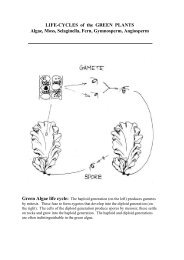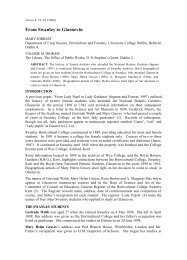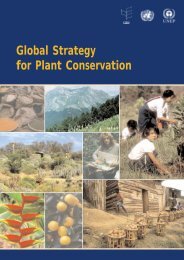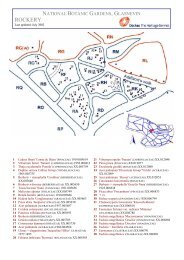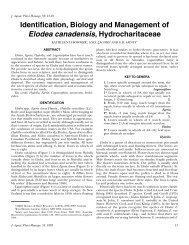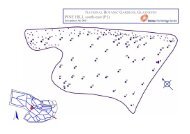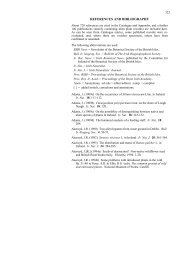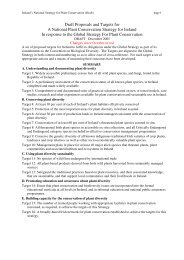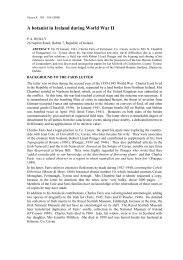6693/ Duchas Interior/ENGLISH - National Botanic Garden of Ireland
6693/ Duchas Interior/ENGLISH - National Botanic Garden of Ireland
6693/ Duchas Interior/ENGLISH - National Botanic Garden of Ireland
You also want an ePaper? Increase the reach of your titles
YUMPU automatically turns print PDFs into web optimized ePapers that Google loves.
An Roinn Comhshaoil agus Rialtais Áitiúil.The Department <strong>of</strong> the Environment and Local Government.Livingwith NatureThe Designation <strong>of</strong> NatureConservation Sites in <strong>Ireland</strong>
ContentsIntroductionTypes <strong>of</strong> Conservation Site Designation pg 4The Designation Process – a Step by Step Guide pg 6Consultation and Planning pg 12The Impact <strong>of</strong> Designation on Farming Practices and Land Use pg 14Compensation for Land Owners and Users pg 19Other Designations pg 20
Living with Nature: The Designation <strong>of</strong> Nature Conservation Sites in <strong>Ireland</strong>IntroductionThe people <strong>of</strong> <strong>Ireland</strong> share the country with 28species <strong>of</strong> land mammal, over 400 species <strong>of</strong> birds,more than 4,000 plant species, over 12,000 species<strong>of</strong> insect, and a huge range <strong>of</strong> other living creatures.If we want all <strong>of</strong> this to survive, we must ensure thatthere are enough areas in the countryside wherethey can flourish.In the recent past, economic success in <strong>Ireland</strong> hasplaced strains never seen before on theenvironment. At the same time, many farmers whoown the land where wildlife occurs are facing adifficult future, and see themselves as threatened. Asagriculture changes, conditions for wildlife change,sometimes for the worse.Of course, many <strong>of</strong> the best wildlife areas in <strong>Ireland</strong>are “marginal” land, or not used for agriculture. Evenhere, technological advances make for newopportunities for exploitation. For example,windfarms provide great possibilities for greenenergy but at the cost <strong>of</strong> disturbance in hithertoisolated and untouched mountain areas.Conserving nature requires a range <strong>of</strong> strategies tosucceed. One <strong>of</strong> these is to ensure conservation <strong>of</strong>habitats where plants and animals live. And not onlythe rare and fragile: we have seen how species oncecommon like the corncrake and the blue cornflower,can disappear if their habitat changes. To succeed,this strategy needs the support <strong>of</strong> landowners andpeople who use or visit the land.So far we have mentioned only the land. There is agreat array <strong>of</strong> life in our seas, which few <strong>of</strong> us everwitness. This too is being affected in a variety <strong>of</strong>ways, as we seize opportunities for new activities inour coastal and <strong>of</strong>fshore waters; and this toorequires protection.What this Booklet ContainsThis booklet <strong>of</strong>fers an overview <strong>of</strong> how and whyareas <strong>of</strong> the country are selected as conservationsites, and where to go for further information andhelp. It contains information and sections dealingwith the following:• The three main types <strong>of</strong> conservation sitedesignation• Reasons why sites are identified for protection• A step-by-step guide to how a site is designated• Appealing or objecting to a designation proposal• The implications <strong>of</strong> having property in aconservation area• Compensation schemes for land ownersand users• Other types <strong>of</strong> protection• Examples <strong>of</strong> conservation areas and the featuresfound on these sites• A map detailing conservation site designationsacross <strong>Ireland</strong>• A list <strong>of</strong> conservation sites <strong>of</strong> Europeanimportance in <strong>Ireland</strong>This booklet is about moves in <strong>Ireland</strong> to conservehabitats and species, by designation <strong>of</strong> conservationareas. This is required <strong>of</strong> us under European law andour own national laws. The Department <strong>of</strong> theEnvironment, Heritage and Local Government isresponsible for the designation <strong>of</strong> conservation sitesin <strong>Ireland</strong>. The Department works with farmers, otherlandowners and users and national and localauthorities to achieve the best balance betweenfarming and land-use on the one hand, andrequirements for conserving nature in these selectedareas, on the other.pg 3
Living with Nature: The Designation <strong>of</strong> Nature Conservation Sites in <strong>Ireland</strong>SACs – Special Areas <strong>of</strong> ConservationThese are prime wildlife conservation areas in thecountry, considered to be important on a Europeanas well as Irish level. They are chosen from thepNHAs, although a number <strong>of</strong> known high qualitysites which are not yet NHAs have also beenincluded. Most SACs are in the countryside,although a few sites reach into town or citylandscapes, such as Dublin Bay and Cork Harbour.The legal basis on which SACs are selected anddesignated is the EU Habitats Directive(92/43/EEC), transposed into Irish law in theEuropean Union (Natural Habitats) Regulations,1997. The Directive lists certain habitats andspecies that must be protected within SACs. Irishhabitats include raised bogs, blanket bogs,turloughs, sand dunes, machair (flat sandy plains onthe north and west coasts), heaths, lakes, rivers,woodlands, estuaries and sea inlets. The 25 Irishspecies which must be afforded protection includeSalmon, Otter, Freshwater Pearl Mussel, BottlenosedDolphin and Killarney Fern. A full list <strong>of</strong> Irishhabitats and species covered by the Directive isgiven at the end <strong>of</strong> the booklet.Some habitats are deemed “priority” and havegreater requirements for designation <strong>of</strong> sites andprotection.Sites that meet criteria laid down by the EUDirective are identified by the Department andproposed for designation. To date, <strong>Ireland</strong> hastransmitted 381 sites to the European Commissionas candidate Special Areas <strong>of</strong> Conservation. Thesecover an area <strong>of</strong> approximately 10,000 squarekilometres. Across the EU, over 12,600 sites havebeen identified and proposed, covering an area <strong>of</strong>420,000 sq. km.SPAs - Special Protection AreasThese sites are areas <strong>of</strong> importance for birds (and<strong>of</strong>ten are important for other types <strong>of</strong> wildlife).The EU Birds Directive (79/409/EEC) requiresdesignation <strong>of</strong> SPAs for:• Listed rare and vulnerable species such asWhooper Swan, Greenland White-frontedGoose, Peregrine Falcon, Corncrake and terns.• Regularly occurring migratory species, such asducks, geese and waders.• Wetlands, especially those <strong>of</strong> internationalimportance, which attract large numbers <strong>of</strong>migratory birds each year. (Internationallyimportant means that 1% <strong>of</strong> the population <strong>of</strong> aspecies uses the site, or more than 20,000 birdsregularly use the site.)Some <strong>of</strong> the listed species conveniently occur inhigh numbers and densities. However, others suchas breeding waders and birds <strong>of</strong> prey, occur at verylow density where designation <strong>of</strong> sites is a moredifficult, although necessary, exercise.To date, 110 SPAs have been designated. A further25 sites have been notified to landowners.Approximately 25 SPAs are also designated SAC.The Irish SPAs join a total <strong>of</strong> around 3,000 sitesacross the European Union.Special Areas <strong>of</strong> Conservation and SpecialProtection Areas collectively form part <strong>of</strong> ‘Natura2000’, a network <strong>of</strong> protected areas throughout theEuropean Union. Across the EU, sites forming part<strong>of</strong> ‘Natura 2000’ cover an area <strong>of</strong> land and sea thesize <strong>of</strong> Germany.pg 5
Living with Nature: The Designation <strong>of</strong> Nature Conservation Sites in <strong>Ireland</strong>The Designation Process –AStep by Step GuideSTEP 1: IDENTIFICATION AND MAPPING OF THE SITEDesignated areas are chosen using:• Previously existing knowledge, such as the list <strong>of</strong>Areas <strong>of</strong> Scientific Interest compiled in the1970s, various publications on important birdareas in <strong>Ireland</strong>; and other surveys;• the NHA survey, carried out from 1991-94;• continuing survey and site visits by Departmentstaff and contractors;• inputs from NGOs, pr<strong>of</strong>essional and amateurecologists.In all cases, proposed sites are evaluated byscientists within the Department before they areallowed forward for designation.Sites should be at least large enough to provide thephysical and semi-natural conditions for themaintenance <strong>of</strong> a particular habitat. In practice thismeans that most sites are over 100 hectares in size,although there are exceptions.Wherever possible the boundaries <strong>of</strong> sites coincidewith identifiable (and mappable) features on theground or water. On land, these may be fences,hedges, ditches, roads and so on. In the case <strong>of</strong>boundaries at sea or in large lakes, the boundarymay be a straight line between visible markers(headlands, islands etc.). High and low tide marksare sometimes used.SAC sites are chosen subject to criteria laid out inAnnex III <strong>of</strong> the Habitats Directive. Broadly speaking,these are as follows:1. The importance within <strong>Ireland</strong> <strong>of</strong> the site for itshabitats or species;2. How “representative” is the example <strong>of</strong> therelevant habitat present on the site (in practice,this means that a suite <strong>of</strong> sites is selected whichencompasses the range <strong>of</strong> variation found);3. How isolated is the population <strong>of</strong> the relevantspecies on the site (the more isolated thepopulation, the more likely it is to be geneticallydifferent from other populations);4. The intactness <strong>of</strong> the habitat on the site; and5. Other factors, including the need to ensure agood geographic spread <strong>of</strong> sites, the totalnumber <strong>of</strong> habitats and species listed in theAnnex to the Habitats Directive present on thesite, whether or not there is a priority habitat onthe site and whether or not the site containshabitats or species for which <strong>Ireland</strong> is especiallyimportant.In all cases, proposedsites are evaluated byscientists within theDepartment before theyare allowed forwardfor designation.pg 6
The Designation Process – A Step by Step GuideLiving with Nature: The Designation <strong>of</strong> Nature Conservation Sites in <strong>Ireland</strong>SPAs are chosen if they area) regularly used by 1% or more <strong>of</strong> the all-<strong>Ireland</strong>population <strong>of</strong> a listed (i.e. Annex 1) species orb) regularly used by 1% or more <strong>of</strong> thebiogeographical population <strong>of</strong> a migratoryspecies orc) regularly used by more than 20,000 waterfowl.In addition, sites important for dispersed speciesrequire protection under the 1979 Birds Directive.The selection criteria for individual NHA habitattypes are being specified. Such requirements willencompass the following:a) protection <strong>of</strong> the site will make a significantcontribution to the conservation <strong>of</strong> one or morespecies (or other biological type) which areconsidered vulnerable, rare or endangered in<strong>Ireland</strong>, or in the Atlantic biogeographical region,or which are covered by any relevant internationaltreaty to which <strong>Ireland</strong> is a party.b) protection <strong>of</strong> the site will make a significantcontribution to the conservation <strong>of</strong> one or morespecies which are protected in <strong>Ireland</strong> undernational or international law.c) protection <strong>of</strong> the site will make a significantcontribution to the conservation <strong>of</strong> one or morehabitats which are considered vulnerable, rare orendangered, either in <strong>Ireland</strong> or in westernEurope.d) the site is one <strong>of</strong> a series selected to representhabitats, or ecosystems which are typical <strong>of</strong><strong>Ireland</strong>.e) the site is one <strong>of</strong> a series <strong>of</strong> sites selected torepresent a range <strong>of</strong> variation <strong>of</strong> habitats whichare typical <strong>of</strong> <strong>Ireland</strong>.f) the protection <strong>of</strong> the site will, in the judgement <strong>of</strong>the Geological Survey <strong>of</strong> <strong>Ireland</strong>, contributesignificantly to the conservation <strong>of</strong> geological,geomorphological or fossil features.pg 7
Living with Nature: The Designation <strong>of</strong> Nature Conservation Sites in <strong>Ireland</strong>The Designation Process – A Step by Step GuideSTEP 2 – ADVERTISEMENT AND NOTIFICATION OF NATURE CONSERVATION SITESOnce a site has been identified, landowners arenotified and it becomes a “proposed NaturalHeritage Area”, “proposed candidate Special Area<strong>of</strong> Conservation” or a “proposed Special ProtectionArea” as the case may be.All reasonable effort is made to identify and notifythe owners <strong>of</strong> lands within these areas. SAC, NHAor SPA map boundaries are sent to landowners sothey can determine whether their land is locatedwithin a conservation area.A freephone number, 1800 40 5000, is available iffurther clarification is required.A list <strong>of</strong> activities that might damage the wildlifeinterests <strong>of</strong> the site, and measures required toprotect the site, is also provided. These arecalled the “Notifiable Actions”.As well as notifying individuals, proposals for NHAs,SACs and SPAs are advertised in the localnewspapers and on local radio. Relevant maps arealso displayed for public viewing in the local <strong>of</strong>fices<strong>of</strong> the Department <strong>of</strong> the Environment, Heritage andLocal Government, the local <strong>of</strong>fices <strong>of</strong> theDepartment <strong>of</strong> Social and Family Affairs, Teagasc/Farm Development Service local <strong>of</strong>fices. Maps willalso be available for consultation in the local countylibrary as well as local Garda Stations.Sites are legally protected once they are publiclyadvertised.Raised Bogs were the first habitat type to berecognised and protected under the provisions <strong>of</strong>the Wildlife (Amendment) Act 2000.75 sites, mainly in midland counties, have beenafforded protection.The notification procedures for NHAs are similar tothose outlined above in respect <strong>of</strong> SACs.pg 8
EXAMPLES OF CONSERVATION AREASSPECIAL AREAS 1: Lough SwillyLiving with Nature: The Designation <strong>of</strong> Nature Conservation Sites in <strong>Ireland</strong>Lough Swilly has both SAC and SPA areas. The SACextends from below Letterkenny to just north <strong>of</strong>Buncrana. The SPA covers the inner Swilly, fromLetterkenny to Whale Head and also includes theestuaries <strong>of</strong> the Leannan and Ray Rivers.Shallow water, intertidal sand and mud flats are the dominanthabitats. Clams, cockles, mussels and polychaete worms arecommon.Lough Swilly is one <strong>of</strong> the most important wetlands for birds in<strong>Ireland</strong>. In autumn and winter, the shallow waters providesuitable habitat for grebes and diving duck, while the intertidalflats are used by an excellent diversity <strong>of</strong> wildfowl and waders.At high tide, the duck and wader species roost on the saltmarshes and shorelines, with some species moving to theadjacent pasture and arable fields.22 species <strong>of</strong> waterfowl occur in nationally important numbers,3 <strong>of</strong> these in internationally important numbers. The Departmentwill shortly propose additional areas for extensions to the SPAto cover all <strong>of</strong> the most important areas.Salt marshes are well represented in the inner sheltered areas<strong>of</strong> the site, with good examples in the Ramelton area. Themarshes are the Atlantic salt meadow type, and arecharacterised by such species as Thrift, Sea Milkwort, Sea Asterand Sea Arrowgrass.Inch Lake and Blanket Nook are man-made lakes with typicalbrackish water species <strong>of</strong> flora and fauna.Two woodlands occur adjacent to the northwestern shore <strong>of</strong>Lough Swilly. These are Rathmullen and Carradoan Woods, theformer being a Nature Reserve. They are dominated by SessileOak and Birch, but many other species are present includingnon-native species such as Beech. These woodlands display agenerally intact structure and support a range <strong>of</strong> breeding birds,including Woodcock.A further area <strong>of</strong> woodland, scrub and heath occurs above thenortheast shore at Crockacashel and at Porthaw. Oak/Hazelscrub is frequent, and there is a well-developed ground florawith species such as Wood-sorrel , Herb Robert, Lady’s fernand Broad Buckler Fern. The SAC supports a population <strong>of</strong>Otter, a species listed on Annex II <strong>of</strong> the EU Habitats Directive.pg 9
Living with Nature: The Designation <strong>of</strong> Nature Conservation Sites in <strong>Ireland</strong>EXAMPLES OF CONSERVATION AREASSPECIAL AREAS 2:Killarney <strong>National</strong>Park, Macgillycuddy’s Reeks andCaragh River CatchmentThis is the largest SAC in the country, encompassing themountains and lakes <strong>of</strong> the Iveragh peninsula, and thePaps Mountains which stretch eastward from Killarneytowards Millstreet. It is the most mountainous region in<strong>Ireland</strong> and includes Carrauntoohil (1039m), the highestpeak in the country. It also includes Killarney <strong>National</strong> Park.The site is <strong>of</strong> great ecological interest, with a great range <strong>of</strong>habitats such as yew wood, oak wood, bog, lakes (upland andlowland), heath (wet, dry and alpine) and rivers. Many <strong>of</strong> thehabitats, are required to be protected, by EU Directives.The site contains many lakes. Most are in a very healthy conditionbut Lough Leane, the largest fresh water body in the region, hasbecome eutrophic as a result <strong>of</strong> pollution from Killarney town andagricultural run<strong>of</strong>f.The rivers associated with these lakes are also <strong>of</strong> importance.Rocks around the smaller mountain streams <strong>of</strong>ten support lushvegetation <strong>of</strong> ferns, mosses and liverworts, most notably at TorcWaterfall.A large number <strong>of</strong> interesting plant and animal species are present.A few examples are:Slender Naiad and Killarney Fern, both singled out for conservationmeasures in the Habitats Directive; and Pillwort, Kerry Lily, IrishLady's Tresses and Slender Cudweed, which are legally protected.The SAC is very important for mosses and ferns and fungi,particularly the woodland species.The <strong>National</strong> Park is also designated as SPA. Important speciesinclude Greenland White-fronted Goose, Peregrine, Merlin,Kingfisher and Common Tern. The woodlands provide habitat for avariety <strong>of</strong> breeding birds, most notably <strong>Garden</strong> Warbler, Blackcap,and probably a few pairs each <strong>of</strong> the rare Redstart and WoodWarbler.The area is valuable for freshwater fish. The Killarney Shad is aunique land-locked subspecies confined to the Killarney lakes. Theglacial relict, Arctic Char, is present in several <strong>of</strong> the lakes and aunique form <strong>of</strong> char is found in Lough Coomasaharn. Salmon,brook lamprey and sea lamprey also occur.There are numerous notable invertebrates within the site, includingKerry Slug, Freshwater Pearl-mussel and the Marsh Fritillarybutterfly. The Kerry Slug and Pearl-mussel populations are <strong>of</strong>particular importance in an international context. Other species <strong>of</strong>note include two emerald-green dragonflies (Cordulia aenea andSomatochlora arctica), which are very rare in <strong>Ireland</strong>.pg 10
The Designation Process – A Step by Step GuideLiving with Nature: The Designation <strong>of</strong> Nature Conservation Sites in <strong>Ireland</strong>STEP 3 - OBJECTIONS AND APPEALSSTEP 4 - DESIGNATIONObjection or appeal can be made against theinclusion <strong>of</strong> a section <strong>of</strong> land in a SAC, SPA orNHA. A person can only make objections if theyhave a legal interest in the site (i.e. an owner or legaluser). They must be made on scientific grounds, e.g.a landowner would show that the relevanthabitats/species/geological features were notpresent in such a condition as to warrantdesignation. Appeals can also be made for theinclusion <strong>of</strong> lands. Appeals should be accompaniedby a map <strong>of</strong> the area <strong>of</strong> concern and be asinformative as possible. There are two stages to theappeals process:1st stage: Internal ReviewTo initiate an internal review <strong>of</strong> proposals to includea section <strong>of</strong> land, write to:Designated Areas Appeal SectionThe Department <strong>of</strong> the Environment, Heritage andLocal Government7 Ely Place,Dublin 2.Alternatively, you may initiate an internal review bycontacting your local Conservation Ranger (seecontact list within this booklet).Local conservation staff <strong>of</strong> the Department will thenre-examine the scientific grounds for including thesection <strong>of</strong> land in question. The ConservationRanger will discuss the matter with you and make arecommendation to local management. You will thenbe informed <strong>of</strong> the outcome <strong>of</strong> the internal review.2nd stage: Appeal to Nature ConservationDesignation Appeals BoardThe Nature Conservation Appeals Board isindependent <strong>of</strong> the Department and is comprised <strong>of</strong>equal representation <strong>of</strong> landowners/users andconservationists. The Board has an independentchairperson. The Board makes a recommendationon each appeal to the Minister who then decides onthe outcome <strong>of</strong> the appeal.You may appeal to the Nature Conservation AppealsBoard only where an application for an internalreview <strong>of</strong> proposals to include a section <strong>of</strong> land hasbeen made and has not been successful.Three months is allowed by law for objections to theproposal to designate a site. In practice, objectionsare given full consideration even after the formal timelimit has expired.Details on each proposed SAC are transmitted tothe EU Commission, after which it is called a“candidate SAC”. All the European candidate sitesare examined by representatives <strong>of</strong> member states,independent scientists and NGO representatives.Once adopted by the EU commission, the sites willbe formally designated by the Minister.SPAs are designated by the Minister withoutreference to the EU, although the Commission canand does seek to ensure that the total areadesignated is adequate within the terms <strong>of</strong> the BirdsDirective.NHAs are designated by the Minister withoutreference to Europe.If you request an internal review, localconservation staff will re-examine thescientific grounds for including theparticular section <strong>of</strong> land within a natureconservation area. The ConservationRanger will discuss the matter with youand make a recommendation to localmanagementpg 11
Living with Nature: The Designation <strong>of</strong> Nature Conservation Sites in <strong>Ireland</strong>Consultation and PlanningAt a national level, the Department consultsregularly with the major farming and conservationgroups as well as other government departments.For consultation at a local level, owners <strong>of</strong> landsand/or rights in designated areas are encouraged t<strong>of</strong>orm Liaison Committees, which are a first point <strong>of</strong>contact for consultation by the Department withinterested parties on the designation andmanagement processes. There are many suchcommittees in existence, and more are being set up.Conservation PlanningThe Department will produce a draft conservationplan for each SAC, SPA and NHA. Each plan willlist the wildlife resources <strong>of</strong> the area, the currenthuman uses, any conflicts between the two, andstrategies for retaining the conservation value. Thisdraft document will be given to the liaisoncommittee and other interested parties fordiscussion and consultation. The Department willthen prepare a final version <strong>of</strong> the conservation plan.Consultation on draft consultation plans has begun.Conservation Plans, once complete, will bereviewed on a 5 year cycle.pg 12
EXAMPLES OF CONSERVATION AREASLiving with Nature: The Designation <strong>of</strong> Nature Conservation Sites in <strong>Ireland</strong>SPECIAL AREAS 3: Hook Headpg 13Hook Head SAC is an area <strong>of</strong> marine subtidal reefs tothe south and east <strong>of</strong> the Hook Head Peninsula andincludes the sea cliffs from Hook Head to Baginbun andIngard Point. The site adjoins the estuary mouth <strong>of</strong>Bannow Bay. Hook Head itself is internationallyimportant for fossils. The site contains two habitatslisted under the EU Habitats Directive, i.e. reefs and seacliffs.The reefs around Hook Head have excellent examples <strong>of</strong>tideswept communities and species richness is high in both theshallow and deep-water communities. The latter is characterisedby cushion sponges, with branching sponges and the rose‘coral’ Pentapora foliacea. In addition the sponge Stryphnusponderosa, the sea squirts Sidnym elegans, Distomusvariolosus and Stolonica socialis and the brittlestar Amphiurasecurigera are present. These species have a limited distributionin <strong>Ireland</strong>. The rare red algae Schixymenia dubyi also occurs.The rocky shorelines and vegetated sea cliffs are characterisedby species such as Thrift, Rock Samphire, Rock Sea-lavender,Sea Plantain, Buck's Horn Plantain, Rock Sea-spurrey and SeaMayweed. The cliffs and headlands are also <strong>of</strong> ornithologicalinterest for breeding Choughs, Ravens and Peregrines, and as alandfall for migrant bird species.
Living with Nature: The Designation <strong>of</strong> Nature Conservation Sites in <strong>Ireland</strong>The Impact <strong>of</strong> Designation onFarming Practices and Land UseFarmingIn most cases where lands are included in a SAC,SPA or NHA, farmers will not have to change theirfarming methods; it is more likely that farmers will berequested to carry on in the traditional way. In somesituations changes may be necessary. TheDepartment consults with farmers and advises themon the appropriate changes that may need to bemade. Where a farmer is required to take particularaction to protect the wildlife interest <strong>of</strong> the site,compensation may be payable, either through theRural Environment Protection Scheme, or based ona Departmental farm plan.It is the responsibility <strong>of</strong> the Department to see thatdesignated sites are protected from significantdamage. Where a landowner is considering makingchanges on his farm that might affect wildlife habitatin a designated area, he must consult the localConservation Ranger beforehand.Developments likely to cause significant damage tothe wildlife importance <strong>of</strong> a designated site will notbe allowed. The only exceptions allowed in SACsand SPAs are for reasons <strong>of</strong> over-riding publicinterest, in the absence <strong>of</strong> any realistic alternative.It is Irish Government policy, and EU policy, not toallow grant-aided developments that damage theenvironment.Notifiable ActionsCertain activities restricted within SACs, SPAs andNHAs can only be carried out with the permission <strong>of</strong>the Minister for the Environment and LocalGovernment. In the case <strong>of</strong> NHAs, 3 months writtenprior notice is required to be given to the Ministerbefore undertaking any notifiable activities. Pleasecontact your local ranger if you require clarification.These are called Notifiable Actions and varydepending on the type <strong>of</strong> habitat that is present onthe site. Landowners are sent copies <strong>of</strong> theNotifiable Actions that are relevant to their lands.For example, Notifiable Actions for a riverbank in aSAC include:• The use <strong>of</strong> fertilisers, pesticide or herbicide nearthe river-bank• The alteration <strong>of</strong> the river flow• The removal <strong>of</strong> trees or vegetation from within 30metres <strong>of</strong> the river-bank• The introduction <strong>of</strong> new species <strong>of</strong> plants oranimals not currently found in the area.For a sand dune area, Notifiable Actions include:• Removal <strong>of</strong> sand• Dumping• Ploughing, reseeding or fertilising• Supplementary feeding <strong>of</strong> livestockWhere a landowner has a current approved farmplan under the Rural Environmental ProtectionScheme (REPS), or an equivalent scheme, thelandowner need only notify the Minister <strong>of</strong> activitiesnot covered in the plan.pg 14
EXAMPLES OF CONSERVATION AREASLiving with Nature: The Designation <strong>of</strong> Nature Conservation Sites in <strong>Ireland</strong>SPECIAL AREAS 4: Lambay Islandpg 15Lambay Island is a large (250 ha.) privately-owned islandlying 4 km <strong>of</strong>f Portrane on the north Co. Dublin coast,which has long been maintained as a wildlife sanctuaryby its owners. The island rises to 127 m and issurrounded by steep cliffs on the north, east and southslopes. The west shore is low-lying and the land slopesgently eastwards to the summit in the centre <strong>of</strong> theisland. Lambay Island is designated as a SAC and SPA.Lambay is internationally important for its breeding seabirds andhas the biggest seabird colony in <strong>Ireland</strong>. The most numerousspecies is the Guillemot, whose nesting population has risenfrom 10,500 in 1970 to 60,000 in 1999. Razorbills, Kittiwakes,Herring Gulls, Shags, Cormorants, Puffins and other seabirdsalso breed here.In winter Greylag Geese use the island, along with smallnumbers <strong>of</strong> Barnacle and Brent Geese.Lambay supports the only colony <strong>of</strong> Grey Seals on the eastcoast. Although it is a long established breeding site for thisspecies, it remains relatively small (45-60 individuals) probablybecause <strong>of</strong> the restricted area suitable for breeding. Grey Sealsare listed on Annex II <strong>of</strong> the EU Habitats Directive.Most <strong>of</strong> the western third <strong>of</strong> the island is intensively farmed(mostly pasture), and there are small areas <strong>of</strong> parkland,deciduous and coniferous woodland, buildings, walled gardensand the harbour. Much <strong>of</strong> the rest <strong>of</strong> the island is a mixture <strong>of</strong>less intensively grazed land, rocky outcrops, patches <strong>of</strong> Brackenand Bramble, and cliff slopes with typical maritime vegetatione.g. Thrift, Sea Campion, Rock Sea-spurrey and Spring Squill.Some sheltered gullies have small areas <strong>of</strong> scrub woodlanddominated by Elder.
Living with Nature: The Designation <strong>of</strong> Nature Conservation Sites in <strong>Ireland</strong>The Impact <strong>of</strong> Designation on Farming Practices and Land UseA landowner can appeal a refusal <strong>of</strong> consent for anotifiable activity, by contacting freephone 1800405 000.Farming prescriptions and Farm PlansIt is a condition <strong>of</strong> a number <strong>of</strong> farm-relatedpayments that the farmer must be signed up foreither a REPS or Departmental farm plan. Thisrequires an agreed approach on how to managefarming in, and around, wildlife habitats. TheDepartment <strong>of</strong> the Environment, Heritage and LocalGovernment has agreed farming prescriptions forsome habitats with the Irish Farmers’ Association(IFA), the Irish Creamery Milk Suppliers Association(ICMSA), and the Department <strong>of</strong> Agriculture andFood. These habitats are: the Burren, blanket bogs,heaths, upland grasslands, sand dune habitats andmachair. Agreement has yet to be reached onprescriptions for a number <strong>of</strong> other habitats such ascallow type land, river banks turloughs and intensivegrasslands, and discussions are on going with therelevant farm organisations.Farm planners will then use these prescriptionswhen drawing up REPS plans or Departmental farmplans.significant damage to SACs and SPAs. As withfarming, developments likely to cause significantdamage to the wildlife importance <strong>of</strong> a designatedsite must not be allowed.Local Authorities (Co. Councils, Corporations etc.)are provided with maps <strong>of</strong> conservation sites in theirareas and are required by law to incorporate theseinto their Development Plans. If a proposeddevelopment is likely to have an adverse effect on asite, an alternative approach may be suggested.SACs do not automatically prohibit development.Developments not causing significant harm to theconservation interest <strong>of</strong> a site may be permitted.Grazing, Sporting and Turf-Cutting RightsThose who own these rights have the sameresponsibility as landowners to ensure that theiractivities do not damage the wildlife quality <strong>of</strong> a site.Any person who illegally damages a site may beprosecuted or required to repair damage.The designation <strong>of</strong> a SAC, SPA or NHA rarelyaffects the shooting interests on the site.Planning ApplicationsPlanning authorities are required by law to ensurethat developments in their area do not cause anypg 16
Living with Nature: The Designation <strong>of</strong> Nature Conservation Sites in <strong>Ireland</strong>The Impact <strong>of</strong> Designation on Farming Practices and Land UseLicencesAll public authorities and Government Ministers wholicence activities in SACs and SPAs must assessapplications in the light <strong>of</strong> the conservation interest<strong>of</strong> the sites. The Minister for the Environment andLocal Government must assess acitivities notlicenced by other Ministers or Authorities. Otherbodies that have direct responsibility forimplementing conservation directives are as follows:The Department <strong>of</strong> Agriculture and FoodThe Department <strong>of</strong> Communications, Marineand Natural ResourcesThe Office <strong>of</strong> Public WorksThe Environmental Protection AgencyLocal AuthoritiesAn Bórd PleanálaThe <strong>National</strong> Roads AuthorityWaterways <strong>Ireland</strong>pg 17
Living with Nature: The Designation <strong>of</strong> Nature Conservation Sites in <strong>Ireland</strong>EXAMPLES OF CONSERVATION AREASSPECIAL AREAS 5: Lough MelvinLough Melvin is a cross-border SAC. Most <strong>of</strong> the lake isin north Leitrim but part is in Fermanagh.Lough Melvin is an “oligo-mesotrophic” lake, i.e a lake with littlebuild-up <strong>of</strong> nutrients in the water. It is 13 km long by 3 km wide.The average depth is 8.5 m with a maximum depth <strong>of</strong> 45 m.A number <strong>of</strong> inflowing and outflowing streams and rivers are inthe SAC, including the Drowes River which links the lake toDonegal Bay. Several large islands occur on the lake.Lough Melvin has a remarkable fish community. It has threeraces <strong>of</strong> Brown Trout (Salmo trutta) - Ferox, Sonaghen andGillaroo - which have distinctive characteristics and separatespawning grounds, and there is much scientific interest in thepossibility that they are really separate species. The lake’sinflowing and outflowing streams, which are used for spawningby these Brown Trout “races”, are included in the site.The Drowes River is an internationally-renowned salmon fishery.In addition to the trout and salmon, there is a population <strong>of</strong> theArctic Char, which has been in the lake since the end <strong>of</strong> the lastIce Age. Char normally go to sea like salmon, but Irishpopulations are land-locked and the fish remain small unlike theirArctic cousins.Moderate numbers <strong>of</strong> waterfowl use the lake and GreenlandWhite-fronted Geese, a species listed on Annex I <strong>of</strong> the EUBirds Directive, have occasionally been reported from the site.The lake has a good diversity <strong>of</strong> aquatic plants, indicative <strong>of</strong>good water quality. Swamp vegetation is generally sparse, beingbest developed in the sheltered bay areas. The most extensiveterrestrial habitat in the site is lowland wet grassland. This ishighly variable throughout the site in both its speciescomposition and species richness.Wet deciduous woodland, dominated by Alder, Goat Willow andDowny Birch, is common in places. Drier woodland exists inother areas, with Hazel, Ash, Holly and Hawthorn andassociated ground cover.Four plant species which are listed in the Irish Red Data Book,Globeflower (Trollius europaeus), Marsh Helleborine (Epipactispalustris), Blue-eyed-grass (Sisyrinchium bermudiana) andTea-leaved Willow (Salix phylicifolia), are found in this site.The Globeflower is also protected under the Flora ProtectionOrder (1999).pg 18
Living with Nature: The Designation <strong>of</strong> Nature Conservation Sites in <strong>Ireland</strong>Compensation for Land Owners and UsersThe Government is committed, as part <strong>of</strong> the socialpartnership process, to the payment <strong>of</strong> a fair andproper level <strong>of</strong> compensation to landowners andusers who have lands proposed for designation as aNHA, SAC or SPA.Rural Environmental Protection Scheme(REPS)Lands within a candidate SAC, designated SPA,proposed NHA or Commonages are defined as‘Target Areas’ under this scheme. Farmers in thetarget areas who participate in the REPS schemereceive higher payments than those elsewhere.Farmers with small areas <strong>of</strong> land in a NHA, SAC orSPA can get REPS payments for that part <strong>of</strong> theirfarm. In either case, the farmer is subject to certainconditions regarding farming and land use practices,set out in the REPS plan for the farm.Departmental Farm PlansWhere a farmer chooses not to participate in REPS,and the Department seeks to change the farmoperation in some way or to end a particular activity,the Department will pay for preparation <strong>of</strong> a farmplan. This will normally be confined just to thedesignated lands, and will address the conservationrequirements. The farm plan will list options forachieving these requirements and indicate the actualcosts to the farmer. The Department and the farmerwill then negotiate an agreement on the plan andpayment <strong>of</strong> the costs.The Department will train farm planners inpreparation <strong>of</strong> farm plans for non-REPS farmers. Alist <strong>of</strong> approved planners will be available to thefarmer to choose from.Compensation for landowners who are notfarmingA landowner may seek compensation for actuallosses incurred as a result <strong>of</strong> having land included ina NHA, candidate SAC or SPA. Eligible landownersshould submit to the Department, details <strong>of</strong> thelosses incurred as a result <strong>of</strong> the inclusion <strong>of</strong> landsin a NHA, SAC or SPA, outlining the basis for thecalculations. Documentary evidence <strong>of</strong> past earningsand the activities that produced these should beincluded with the claim. Should the applicant bedissatisfied with a compensation that is made, thecase may be referred to an independent arbitratorwho will review the matter and make a final decision.Where a proposed SAC/NHA/SPA prevents thelandowner from carrying out an activity ordevelopment on their land, the compensation duewill exclude any payments that have been attractedunder grant schemes (other than headage or premiapayments).AquacultureThe compensatory arrangements outlined aboveapply also to aquaculture / foreshore licenceholders, who may seek compensation for actuallosses incurred as a result <strong>of</strong> having their area <strong>of</strong>operations included in a candidate SAC / SPA.Eligible licence holders wishing to use this optionshould submit to the Department, details <strong>of</strong> thelosses incurred as a result <strong>of</strong> the inclusion <strong>of</strong> landsin a proposed candidate SAC or SPA, outlining thebasis for the calculations. Documentary evidence <strong>of</strong>past earnings, and the activities that producedthese, should be included with the claim.The Department will prepare conservation plans inconsultation with local interest groups. These planswill take account <strong>of</strong> aquaculture, fishing and leisureactivities. Compensation will be provided for actualincome loss due to the implementation <strong>of</strong> theseplans.pg 19
Living with Nature: The Designation <strong>of</strong> Nature Conservation Sites in <strong>Ireland</strong>Other designationsNature ReservesA Nature Reserve is an area <strong>of</strong> importance towildlife, which is protected under Ministerial order.Most are owned by the State. However, some areowned by organisations or private landowners, andpersons interested in acquiring statutory protectionfor their lands can seek advice on this matter fromthe Department.Flora Protection OrderUnder the Wildlife Act, 1976, particular plants areprotected under a Flora Protection Order. It is an<strong>of</strong>fence to cut, uproot or damage these plantsunless under licence from the Minister for theEnvironment, Heritage and local Government. It isalso an <strong>of</strong>fence to wilfully damage or interfere withthe habitat in any way except under licence. TheFlora Protection Order lists 68 species for strictprotection.Refuge for Fauna or FloraUnder the Wildlife Acts, the Minister may designateRefuges for wild birds or wild animals or flora andimpose protective measures to conserve both thespecies and their habitats. Seven such refugesalready exist; they are mainly islands or cliff faces.Wildfowl SanctuariesThese sanctuaries are areas that have beenexcluded from the ‘Open Season Order’ so thatgame birds can rest and feed undisturbed. There are68 sanctuaries in the State. Shooting <strong>of</strong> game birdsis not allowed in these sanctuaries.Management AgreementsThe Wildlife Act, 1976, enables the Minister to enterinto a voluntary management agreement with privatelandowners. Under these agreements landownerswill manage their lands to ensure that desirablewildlife habitats are protected. Payment for suchresponsible management may be agreed. However,the number and type <strong>of</strong> such agreements dependson the resources available to the Department at anytime.CANDIDATE SPECIAL AREAS OFCONSERVATION IN IRELANDSPECIAL PROTECTION AREAS –PROPOSED AND EXISTINGpg 20
EXAMPLES OF CONSERVATION AREASLiving with Nature: The Designation <strong>of</strong> Nature Conservation Sites in <strong>Ireland</strong>SPECIAL AREAS 6: East Burren ComplexThis SAC covers 18,800 hectares <strong>of</strong> the Burren in northClare and a small part <strong>of</strong> southwest Galway. The areaencompasses a complete range <strong>of</strong> limestone habitatsthat include the largest expanse <strong>of</strong> limestone pavementin the country, and includes one <strong>of</strong> the most importantand extensive examples <strong>of</strong> a low-nutrient wetlandsystem. It holds an array <strong>of</strong> habitats associated withlimestone, including orchid-rich grassland, heath, scrub,woodland, lakes and turloughs. The site exhibits some <strong>of</strong>the best limestone wetlands to be found in Europe.The Burren is renowned for its plant life, including species suchas Spring Gentian, Mountain Avens and Bloody Cranesbill.There are 8 turloughs within the site. Turloughs are lake basinswhich fill in the winter months and dry out during summer. Theyhave a distinctive and unusual vegetation and some specialistanimals associated with them.The SAC hosts Lesser Horseshoe Bat, a cave-dwelling specieswhich is in decline across Europe. Pine martens arewidespread.When winter arrives in the east Burren wetlands, Mute andWhooper Swan come in large concentrations. Wigeon,Lapwing, Dunlin, Black-tailed Godwit and Goldeneye arenumerous. Greenland White-fronted Geese also occur.SPECIAL AREAS 7: Bandon RiverThe site consists <strong>of</strong> relatively short adjoining stretches <strong>of</strong>the Bandon and Caha rivers in west Cork and isdesignated as both a site <strong>of</strong> national importance (NHA),and European importance (SAC). The area is significantfor a number <strong>of</strong> reasons. It contains small though veryimportant examples <strong>of</strong> two priority habitats, AlluvialForest and Floating River Vegetation. Otter, Salmon,Brook Lamprey and Freshwater Pearl Mussel are allspecies listed in the Habitats Directive that are presenton the site. The population <strong>of</strong> mussel is thought to benationally important.pg 21
Living with Nature: The Designation <strong>of</strong> Nature Conservation Sites in <strong>Ireland</strong>HABITATS LISTED IN ANNEX 1 OF THE HABITATS DIRECTIVE FOR WHICH SITESHAVE BEEN SELECTED IN IRELANDPRIORITY HABITATS• Coastal Lagoons (Code 1150)• Fixed Coastal Dunes withHerbaceous Vegetation(Grey Dunes) (Code 2130)• Decalcified Fixed Dunes withEmpetrum nigrum (Code 2140)• Atlantic Decalcified Fixed Dunes(Code 2150)• Machair (Code 21ao)• Turloughs (Code 3180)• Semi-Natural Dry Grassland andScrubland Facies on CalcareousSubstrates (Code 6210)• Species-Rich Nardus Grasslands, onSiliceous Substrates in MountainAreas (Code 6230)• Active Raised Bogs (Code 7110)• Blanket Bog (Active) (Code 7130)• Calcareous Fens with Cladiummariscus (Code 7210)• Petrifying Springs with TufaFormation (Code 7220)• Limestone Pavements (Code 8240)• Bog Woodland (Code 91d0)• Alluvial Forest (Code 91e0)• Taxus baccata Woods <strong>of</strong> theBritish Isles (Code 9580)NON-PRIORITY HABITATS• Sand Banks which are slightlycovered by sea water at all times(Code 1110)• Estuaries (Code 1130)• Mudflats and Sandflats not coveredby seawater at low tide(Code 1140)• Large Shallow Inlets and Bays(Code 1160)• Reefs (Code 1170)• Annual Vegetation <strong>of</strong> Drift Lines(Code 1210)• Perennial Vegetation <strong>of</strong> Stony Banks(Code 1220)• Vegetated Sea Cliffs <strong>of</strong> the Atlanticand Baltic Coasts (Code 1230)• Salicornia and other AnnualsColonizing Mud and Sand(Code 1310)• Atlantic Salt Meadows(Code 1330)• Mediterranean Salt Meadows(Code 1410)• Mediterranean and Thermo-AtlanticHalophilous Scrubs (Code 1420)• Embryonic Shifting Dunes(Code 2110)• Shifting Dunes Along The Shorelinewith Ammophila arenaria(White Dunes) (Code 2120)• Dunes with Salix repens ssp.argenta (Code 2170)• Humid Dune Slacks (Code 2190)• Oligotrophic Waters containing veryfew minerals <strong>of</strong> Sandy Plains (Code3110)• Spartina Swards (Code 1320)• Oligotrophic to MesotrophicStanding Waters (Code 3130)• Hard Oligo-Mesotrophic Waters withBenthic Vegetation <strong>of</strong> Chara Spp.(Code 3140)• Natural Eutrophic Lakes(Code 3150)• Natural Dystrophic Lakes and Ponds(Code 3160)• Water Courses <strong>of</strong> Plain to MontaneLevels with Aquatic Vegetation(Code 3260)• Rivers with Muddy Banks withChenopodion Rubri p.p. andBidention p.p. Vegetation(Code 3270)• Northern Atlantic Wet Heaths withErica tetralix (Code 4010)• European Dry Heaths (Code 4030)• Alpine and Boreal Heaths(Code 4060)• Juniperus communis Formations onHeaths or Calcareous Grasslands(Code 5130)• Calaminarian Grasslands(Code 6130)• Molinia Meadows on Calcareous,Peaty or Clayey-Silt-Laden Soils(Code 6410)• Hydrophilous Tall Herb FringeCommunities (Code 6430)• Lowland Hay Meadows (Alopecuruspratensis, Sanguisorba <strong>of</strong>ficinalis)(Code 6510)• Degraded Raised Bogs Still Capable<strong>of</strong> Natural Regeneration(Code 7120)• Transition Mires and Quaking Bogs(Code 7140)• Alkaline Fens (Code 7230)• Siliceous Screes (Code 8110)• Calcareous and Calc Schist Screes(Code 8120)• Calacareous Rocky Slopes withChasmophytic Vegetation(Code 8210)• Sileceous Rocky Slopes withChasmophytic Vegetation(Code 8220)• Caves Not Open To The Public(Code 8310)• Old Sessile Oak Woods with Ilexand Blechnum in British Isles(Code 91a0)• Submerged or Partly SubmergedSea Caves (Code 8330)SPECIES LISTED IN ANNEX II OFTHE HABITATS DIRECTIVE FORWHICH SITES HAVE BEENSELECTED IN IRELAND• LESSER HORSESHOE BAT(Rhinolophus hipposideros)• OTTER (Lutra lutra)• GREY SEAL (Halichoerus grypus)• COMMON SEAL (Phoca vitulina)• BOTTLE-NOSED DOLPHIN(Tursiops truncatus)• PORPOISE (Phocaena phocaena)*• BROOK LAMPREY(Lampetra planeri)• RIVER LAMPREY(Lampetra fluviatilis)• SEA LAMPREY(Petromyzon marinus)• SALMON (in fresh waters only)(Salmo salar)• TWAITE SHAD (Alosa fallax)including KILLARNEY SHAD(A. f. killarnensis)• WHITE-CLAWED CRAYFISH(Austropotamobius pallipes)• MARSH FRITILLARY BUTTERFLY(Euphydryas aurinia)• KERRY SLUG(Geomalacus maculosus)• FRESH WATER PEARL MUSSEL(Margaritifera margaritifera)• FRESHWATER PEARL MUSSEL(Margaritifera durrovensis)**• WHORL SNAIL Vertigo angustior• WHORL SNAIL Vertigo geyeri• WHORL SNAIL Vertigo moulinsiana• KILLARNEY FERN(Trichomanes speciosum)• SLENDER NAIAD (Najas flexilis)• MARSH SAXIFRAGE(Saxifraga hirculus)• SHINING SICKLE MOSS(Drepanocladus vernicosus)• PETALWORT (Petallophyllum ralfsii)* site selection process not yetcomplete** now believed to be a form <strong>of</strong>Margaritifera margaritiferapg 22



